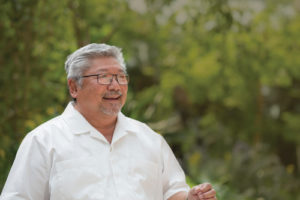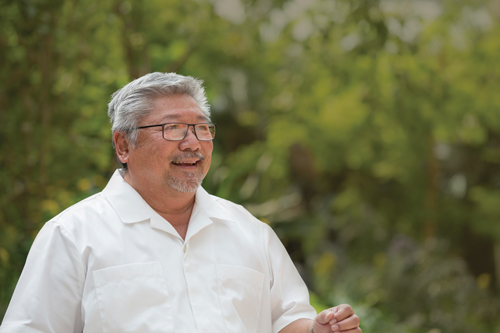It’s about nation-building, country branding and an entertaining tourism attraction. Raini Hamdi talks to Tan Wee Kiat, the man who envisioned Singapore’s Gardens by the Bay and coined its ‘city in the garden’ catchphrase
 What does the job of CEO of Gardens by the Bay entail?
What does the job of CEO of Gardens by the Bay entail?
Well, Gardens by the Bay is a child of my vision, so it is to see through its development, operation and realise its potential.
Let’s go back to the roots: what did you envision for this garden and why?
I envisioned a horticulture display garden, much like Wisley (south of Surrey, London). We already have a botanical garden, so why not create a counterpoint in product distinction.
Botanical gardens are a living museum of plant family for education and research. Here, we cater primarily to the entertainment aspects – the visual, the aesthetic senses. We are the first tropical nation that has developed a garden of this scale, uniquely designed for Singapore and to showcase the plants of the tropics.
So it’s a horticulture theme park but underlying it is some ambitious proposition. It has to do with the branding of Singapore and giving Singaporeans an ownership of Singapore. It’s our park, here in a prime downtown spot, open everyday from 05.00 to 02.00. Only about four per cent is charged (the Flower Dome).
Why would I want to sacrifice for my nation if I don’t own a part of it? Every Singaporean should be able to say ‘the best part of Singapore also belongs to me’.
How does it help with the branding of Singapore?
The concept was mooted to the government in 2004. At the time, Singapore was positioning itself as a global city, competing with other cities for investment and talent. We needed to make sure the Singapore brand was strong.
Was it easy to get the buy-in?
The timing was perfect. URA (Urban Redevelopment Authority) was developing the downtown to be a mini Manhattan; in future people would need breathing space from the tall buildings that cluster around it. What does Manhattan have that makes it a wonderful? A central park. Gardens by the Bay is one-fifth the size of Central Park.
But Singapore government as you know is a tough nut to crack. It is very pragmatic and, unless you can convince it of the financial and economic harvest from such a project, it would not have taken off.
Gardens are also a borrowed concept for our region. It’s not in our culture, in fact, we clear forests in order to survive.
How did you convince the government?
We engaged Edmund Tie (real estate consultant) and PricewaterhouseCoopers to do a study on what value would you increase to a piece of real estate if you were to plant a garden right in the heart of it? We already have a precedent with the Singapore Botanical Gardens where the value of the land around it increased (with the gardens) but I needed professionals to crunch the concept.
Although we don’t have to make a profit, we must not be a white elephant and we must impart value far beyond what is invested. As you can see, we’re not a white elephant. We passed the eight millionth visitor mark in one year and eight months.
Are they all elderly, and British?
(Laughs) Ten per cent of school children in Singapore come here as part of their curriculum. It pleases me too that our locals are coming in with their family after work and during the weekends.
In general, 60 per cent of visitors to the external areas are locals, 40 per cent are tourists from many countries. For the Flower Dome, the ratio is the reverse. We did one promotion to travel agencies in India and suddenly, we had an influx of India visitors to this garden. China too.
How compelling are gardens as a tourist attraction?
From our surveys and how we see visitors do the publicity job for us on social media, gardens are a compelling attraction.
Suddenly photographers are also here as the bird population has increased with the flourishing plants.
We haven’t finished the work here. We’re still trying to train and get the right people to keep the attraction alive and competitive. Our competition is not local but global and we don’t compete with gardens but theme parks and other attractions. People asked, but wouldn’t you be taking away numbers from the zoo or the botanical gardens? No, in fact, there’s one more attraction for visitors to visit and it helps increase the length of stay by half a day.
That’s why part of my role as CEO is to ensure the product, the programming, the service we offer keeps us ahead of the competition globally.
Do you still have naysayers?
You still have people who have never stepped foot into the gardens and say, oh, what a waste of money, it’s all architecture. Why do you need to make fake super trees? Hey, they are also super chimneys! And architecture is the form and shape that attract you, but once you come in, it’s the content. Being on the equator, we have access to the broadest range of plants in the world and we are able to grow them outdoors as we have perpetual summer. The icing is the cool dome, where we can bring in the elements of spring and fall.
This garden, more than any other, combines architecture engineering and nature in its creation. Take the super trees, for instance. We are on reclaimed land where it is almost impossible to achieve the kind of trees you would find in a natural forest, where forest giants after a century obtain 60m, 70m height. In creating the super trees, we impart the same functions to these man-made trees – they trap energy, for example. They are a necessary component of our chilling system.
What man destroys, man can take remedial action. We’ve proven you can recreate nature on reclaimed land.
Can you recreate even in cities such as, say, Bangkok or Beijing?
Why not? Look at Seoul. It developed a central park next to a river which was buried under a highway. It completely eradicated all the structures on top, unearthed the river through the central part of Seoul and brought nature to the heart of the city. Expensive, but it created value. Part of a slum became an elegant centre. It can be done as long as you have young people who work in a dense environment and hunger for a bit of nature. It is in us to want to be back in the forest because we are animals.
10 NEED TO KNOWS ABOUT TAN WEE KIAT
• Who is in your family? One mother; three sisters; four brothers; 10 nephews and nieces; four dogs; countless fishes
• What do you do for fun? Work
• Your ideal vacation? Sleeping in
• How do you book your own leisure trips? Leisure trips?
• What are you reading right now? iPad for iDiots
• How do you stay healthy? By being happy
• Favourite food? Whatever is bad
• A bad habit you cannot kick? Favourite food
• Your pet peeve, something that never fails to annoy you? In the words of the late David Marshall, “sanctimonious posturers”
• Most people don’t know that you can… And they will continue in their ignorance




















